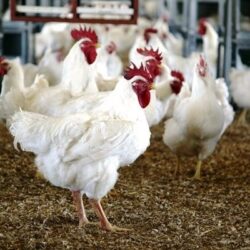CONCRETE BEEHIVES EMPOWER SMALLHOLDER FARMERS AND SAVE BEES
When industrial design student Ivan Brown from the University of Johannesburg had to choose a topic for his Master’s Degree, he was looking for ways improve the livelihoods of smallholder farmers. The outcome, the Beegin project, provides a tool for smallholder and urban farmers to increase their income, as well as conserving one of our most important agricultural resources – the honey bee.
CAN YOU PROVIDE A BIT OF BACKGROUND OF HOW AND WHEN YOU CAME UP WITH THIS IDEA?
The design of the Appropriate Beekeeping Technology system came out of my Master’s of Industrial Design research project, at the University of Johannesburg.
Initially I was looking for opportunities to develop appropriate technologies that could boost the productivity and income of small-scale, urban farmers involved in the inter-departmental urban farming initiative Izindaba Zokudla (a farmer’s training facility based in Soweto).
Many of the farmers were interested in beekeeping, but could not afford or access the equipment and were unsure of entering the beekeeping industry at a time when it seems to be falling apart globally.
After doing a bit of a deeper research dive into the industry I realised that a solution for emergent beekeepers would also need to address the issues (theft, vandalism, fires, pests, diseases, maintenance, cost, etc.) faced by existing beekeepers.
So, I embarked on a participatory, human-centered design research project that aimed to create a more appropriate (accessible and sustainable) beekeeping system, the outcome of which was the lightweight concrete beehives and their low-tech production tools, as well as a range of periphery products like DIY suits and honey extractors.
Ivan Brown alongside his designs for the Longstroth (left) and Kenyan Top-Bar (right) concrete hives.
HOW WOULD THIS DESIGN EMPOWER SMALLHOLDER FARMERS?
The goal of my project was to contribute to food security indirectly by creating opportunities for income through the production of valuable bee products, and directly by helping protect our most valuable pollinators.
Small-scale farmers can benefit from having a hive that takes up very little space, produces honey to sell (average of R3000 (US$215) per hive annually) or replace sugar (average R500 (US$35) per year) in their diet, and pollinates their food crops (increasing the yield and genetic diversity).
The Beegin beehives specifically offer a more sustainable opportunity for farmers and beekeepers to keep bees. The concrete hives are more protective, better insulated (increasing yield greatly), resistant to fires, badger proof, vandal proof, theft proof, cheaper and more durable than the typical wooden versions.
Additionally, I have designed the production tools (moulds) for the beehives to be made easily and locally by beekeepers and farmers that wish to make their own equipment and sell/provide hives to their local community, so there is a secondary level of potential economic benefit.
Farmers harvesting hoeny from the concrete hives.
CAN YOU PROVIDE A BIT OF BACKGROUND ON ALL THE PRODUCTS? WHAT ARE THE CHARACTERISTICS AND DIMENSIONS OF EACH OF THE BEE BUNKERS?
The concrete beehives are based on the same typical dimensions of the Langstroth beehive and the Kenyan Top-Bar hives. The Langstroth hive uses the same standardised wooden frames from the typical wooden hives, making it slightly more expensive.
Although I am working on my own design to produce the frames, to reduce costs (and machinery requirements) and increase their durability (will be available in January too).
The Langstroth hives are suited to larger beekeeping operations, with a better efficiency and productivity as compared to the HTB hives. However, the Langstroth hive system generally requires the use of a centrifugal extraction machine which can be expensive.
The HTB hive on the other hand uses simpler/cheaper wooden bars on the inside and requires no extraction tools other than a cloth for straining the honey from the wax. With the HTB system the entire wax comb is harvested, as opposed to the Langstroth system where the empty wax comb (held on the frames) is placed back into the hive for refilling.
Both systems have their merits, and the HTB hive is often preferred for its simplicity and low-impact inspections which keep our aggressive bee species calmer. I offer both because of the price and manufacturing differences associated with the frames, and to support individuals with different requirements.
The main components of the beehives (base chambers) weigh 60 kg, but are not moved after they have been installed. The lids and super chambers that are moved frequently weigh 23 kg at the most.
I admit though that these beehives are for sedentary beekeepers, and not those that move their hives regularly for pollination services. Part of the idea behind the project is also to make beekeeping more attractive to farmers, of all scales, to reduce the migratory pollination industry which is contributing hugely to the spread of diseases/pests, and often run by beekeepers who don’t care about the health of their bees (make money from contracts not from honey).
Honey harvest! Even thought the size of the harvest remains the same, beekeepers will be able to produce more times per season due to the higher productivity of the bees in the concrete hives.
WHERE THERE ANY INTERESTING OBSERVATION MADE DURING THE FIELD TESTING?
We saw a 200% to 300% increase in productivity in some of our hives during the field testing (as compared to wooden hives that were initiated at the same time and with similar swarms and kept in the same locations).
The testing was on quite a small scale and the results may have been subject to a variety of factors, but we believe that the increase was largely due to the insulating characteristics of the lightweight concrete. We also found a decreased proliferation of pests like mites, moths and beetles in the concrete hives. The pests seemed to prefer the wooden hives, where they could use small gaps to enter and burrow into the material to lay eggs and protect themselves from the bees.
We conducted successful burn treatment tests to determine if the concrete components could be sterilised to remove bacterial infections (wooden hives with foulbrood infections are burnt).
WHERE WOULD THE PRODUCTS BE AVAILABLE? WOULD IT BE AVAILABLE IN OTHER COUNTRIES?
I am in contact with people from all over the subcontinent who need the production tools, so I will make the products available internationally. I will be selling (and delivering probably) the moulds directly, available from the website (www.beegin.co.za). The beehives I will also sell directly to people nearby (Gauteng area), and I will hopefully stock them to existing beekeeping supply stores, but my hope is that people buy the moulds and start selling the hives to their local communities so we can decrease the carbon emissions involved.
DESCRIBE THE “AIR CONDITIONING” ABILITIES OF THE BEEHIVES
The beehives do facilitate the flow of air, but more important is the insulating characteristics. I use the lightweight aggregate Perlite as a component in the concrete mixture, which has the benefit of lightening the components and increasing their thermal insulation properties.
In hot and cold weather the bees expend a great deal of energy regulating the temperature of the hive to keep the larvae alive. The energy is made by consuming honey, and by insulating the bees from temperature variations the hives become more productive and efficient. The Perlite can be substituted for Vermiculite, both aggregates are used in agriculture for water retention in soils and plant-beds, and are starting to become widely used in construction for insulation and lightweight structures.
HOW EASY WOULD IT BE TO USE THE MOULDS AND ARE THERE ANY INSTRUCTIONS?
I like to say it’s as easy as baking a cake, but there is some technique to it. But its way easier than making a wooden hive. The low-tech production system means that no electricity or expensive tools are required, just the moulds and materials. The moulds will come with a detailed instruction manual illustrating the mixtures and process. I will also be posting videos on the website explaining how to set-up the moulds, cast the concrete and demould the parts.
Farmers can buy these moulds to make and produce their own concrete for their own use or to sell it to other farmers.
Insights from a farmer and a beekeeper
According to beekeeper, Danie Peach, from Bee Unique, who provides pollination services and extracts honey in the Free State and North West provinces in South Africa, the advantage of the hives are the enhanced isothermal properties of the concrete hive compared to wooden ones.
“My observation was that bees used less energy to keep the internal temperature of the beehive at 36°C. This meant they spent more energy on other tasks, like organisation etc. The swarm increases much quicker after the winter and they are able to produce honey at an earlier stage.”
He said that the harvest per hive remains the same due to size, but he could harvest more frequently per season.
During the time he tested the concrete hives, he had a problem with small hive beetles in his wooden hives, and observed to have less of a problem in his concrete hives with the pest.
According to Peach he is very excited about the moulds. “I want to incorporate the use of the moulds into my business. I am convinced these concrete structures are more durable and would need much less maintenance.”
However, he said he would not be able to completely do away with wooden hives. The heavier concrete structures make moving more difficult and he would still utilise them for his pollination services when he must move the bees to the crops, as well as for catching bees.
TIM ABBAH – URBAN FARMER
Tim Abbah from Tim’s Nectar Farms, an urban farmer at Orange Farm in Johannesburg, keeping bees in his fruit and vegetable gardens provides several advantages. “The bees provide security in my gardens because we don’t have gates in fences around our gardens, they pollinate my crops, provide me with honey and I can utilise the wax, which is a by-product.”
Before Abbah was introduced to the concrete hives he extracted honey from a beehive that was in a rock on his farm. “These new concrete beehives mean the quality of the honey is now much better and means an extra income opportunity. Now the bees are protected against the weather conditions, parasites etc and the hives would last much longer.”
Abbah, who also facilitates training for other urban farmers, said he would like to train the farmers to use the moulds to produce their own beehives to address the high rates of unemployment in his area. “Now they can get an income from the beehives, bees and honey.”
COST?
– Longstroth – about R1 000 (US$74)
– HTB – R700 (US$52)
– The mould sets (lid moulds and chamber moulds) will be sold at roughly R7 000(about US$520- not finalised yet- prices finalised and available on website in January) each.
The cost (home-made/materials) for people that have the moulds will be very cheap (about R500 (US$ 37) per Langstroth hive).
Basically, the same price as general beehives, but they will last about 10 times longer, so 10 times cheaper!
Contact details:
Email: ivan@beegin.co.za
Website: www.beegin.co.za
Facebook: facebook/beeginSA




